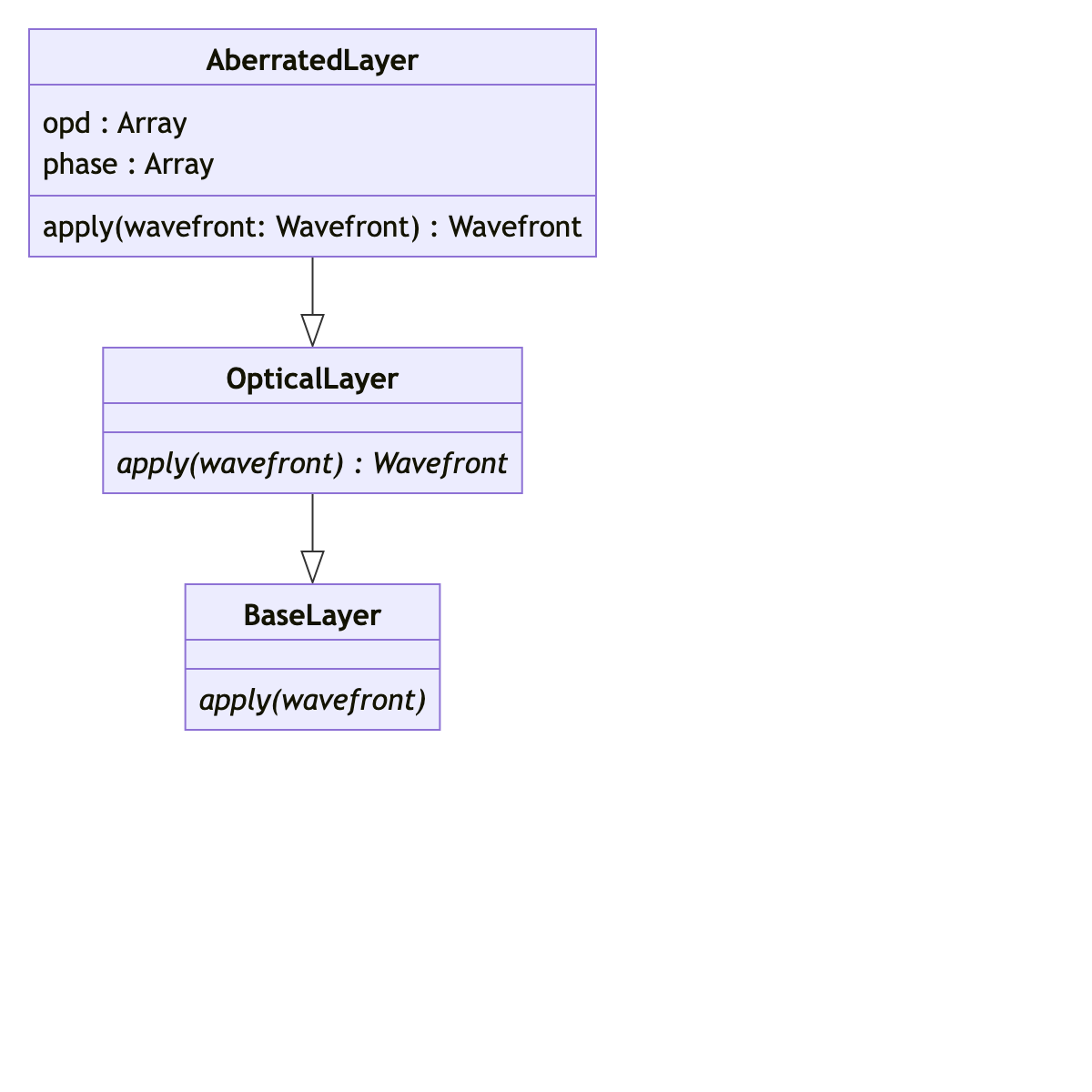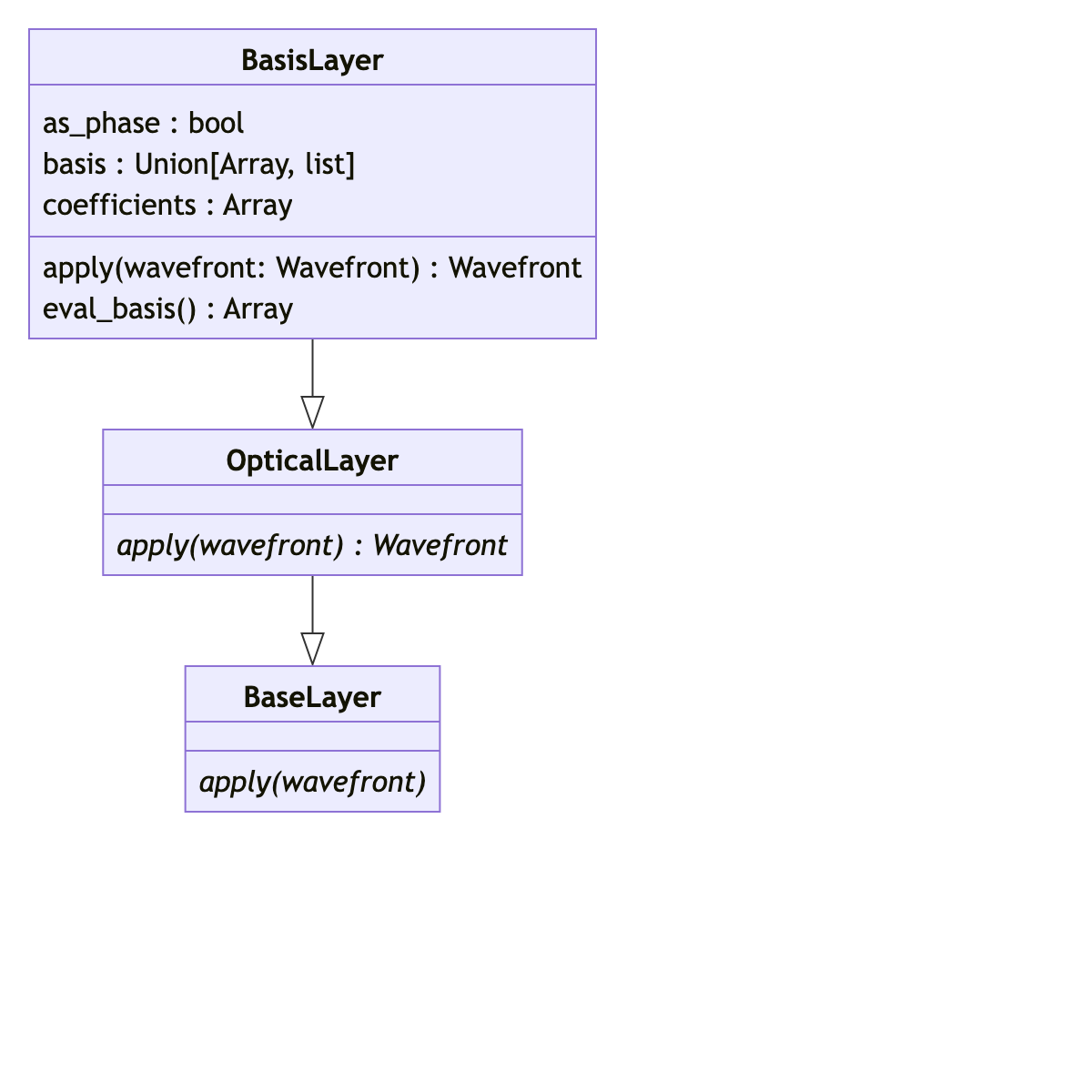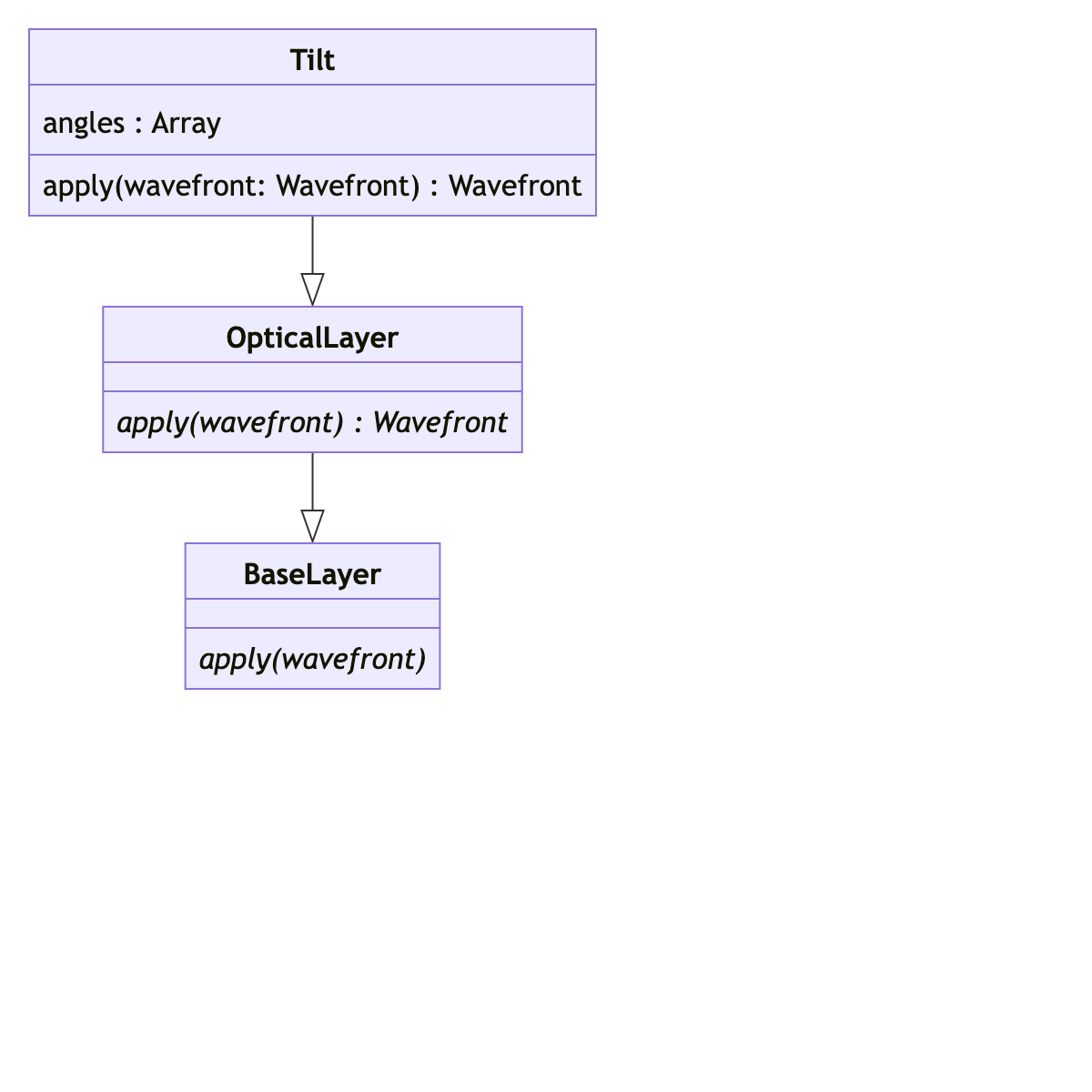Optical Layers
TransmissiveLayer
Bases: OpticalLayer
Base class to hold transmissive layers imbuing them with a transmission and normalise parameter.
UML

Attributes:
| Name | Type | Description |
|---|---|---|
transmission |
Array
|
The Array of transmission values to be applied to the input wavefront. |
normalise |
bool
|
Whether to normalise the wavefront after passing through the optic. |
Source code in src/dLux/layers/optical_layers.py
52 53 54 55 56 57 58 59 60 61 62 63 64 65 66 67 68 69 70 71 72 73 74 75 76 77 78 79 80 81 82 83 84 85 86 87 88 89 90 91 92 93 94 95 96 97 98 99 100 101 102 103 104 105 106 107 108 | |
__init__(transmission=None, normalise=False, **kwargs)
Parameters:
| Name | Type | Description | Default |
|---|---|---|---|
transmission
|
Array
|
The array of transmission values to be applied to the input wavefront. |
None
|
normalise
|
bool = False
|
Whether to normalise the wavefront after passing through the optic. |
False
|
Source code in src/dLux/layers/optical_layers.py
71 72 73 74 75 76 77 78 79 80 81 82 83 84 85 86 87 88 89 | |
apply(wavefront)
Applies the layer to the wavefront.
Parameters:
| Name | Type | Description | Default |
|---|---|---|---|
wavefront
|
Wavefront
|
The wavefront to operate on. |
required |
Returns:
| Name | Type | Description |
|---|---|---|
wavefront |
Wavefront
|
The transformed wavefront. |
Source code in src/dLux/layers/optical_layers.py
91 92 93 94 95 96 97 98 99 100 101 102 103 104 105 106 107 108 | |
AberratedLayer
Bases: OpticalLayer
Optical layer for holding static aberrations. Aberrations can be applied as either a phase or OPD, or both.
UML

Attributes:
| Name | Type | Description |
|---|---|---|
opd |
(Array, metres)
|
The Array of OPD values to be applied to the input wavefront. |
phase |
(Array, radians)
|
The Array of phase values to be applied to the input wavefront. |
Source code in src/dLux/layers/optical_layers.py
111 112 113 114 115 116 117 118 119 120 121 122 123 124 125 126 127 128 129 130 131 132 133 134 135 136 137 138 139 140 141 142 143 144 145 146 147 148 149 150 151 152 153 154 155 156 157 158 159 160 161 162 163 164 165 166 167 168 169 170 171 172 173 174 175 176 | |
__init__(opd=None, phase=None, **kwargs)
Parameters:
| Name | Type | Description | Default |
|---|---|---|---|
opd
|
Array, metres = None
|
The Array of OPD values to be applied to the input wavefront. |
None
|
phase
|
Array, radians = None
|
The Array of phase values to be applied to the input wavefront. |
None
|
Source code in src/dLux/layers/optical_layers.py
130 131 132 133 134 135 136 137 138 139 140 141 142 143 144 145 146 147 148 149 150 151 152 153 154 155 156 157 158 | |
apply(wavefront)
Applies the layer to the wavefront.
Parameters:
| Name | Type | Description | Default |
|---|---|---|---|
wavefront
|
Wavefront
|
The wavefront to operate on. |
required |
Returns:
| Name | Type | Description |
|---|---|---|
wavefront |
Wavefront
|
The transformed wavefront. |
Source code in src/dLux/layers/optical_layers.py
160 161 162 163 164 165 166 167 168 169 170 171 172 173 174 175 176 | |
BasisLayer
Bases: OpticalLayer
An OpticalLayer class that holds a set of basis vectors and coefficients, which are
dot-producted at run time to produce the output. The basis can be applied as either
a phase or OPD, by setting the as_phase attribute.
UML

Attributes:
| Name | Type | Description |
|---|---|---|
basis |
Union[Array, list]
|
The set of basis vectors. Should in generate be a 3 dimensional array. |
coefficients |
Array
|
The array of coefficients to be applied to each basis vector. |
as_phase |
bool = False
|
Whether to apply the basis as a phase or OPD. If True the output is applied as a phase, else it is applied as an OPD. |
Source code in src/dLux/layers/optical_layers.py
179 180 181 182 183 184 185 186 187 188 189 190 191 192 193 194 195 196 197 198 199 200 201 202 203 204 205 206 207 208 209 210 211 212 213 214 215 216 217 218 219 220 221 222 223 224 225 226 227 228 229 230 231 232 233 234 235 236 237 238 239 240 241 242 243 244 245 246 247 248 249 250 251 252 253 254 255 256 257 258 259 260 261 262 263 264 265 266 267 268 269 270 | |
__init__(basis=None, coefficients=None, as_phase=False, **kwargs)
Parameters:
| Name | Type | Description | Default |
|---|---|---|---|
basis
|
Array
|
The set of basis vectors. Should in generate be a 3 dimensional array. |
None
|
coefficients
|
Array
|
The Array of coefficients to be applied to each basis vector. |
None
|
as_phase
|
bool
|
Whether to apply the basis as a phase or OPD. If True the output is applied as a phase, else it is applied as an OPD. |
False
|
Source code in src/dLux/layers/optical_layers.py
204 205 206 207 208 209 210 211 212 213 214 215 216 217 218 219 220 221 222 223 224 225 226 227 228 229 230 231 232 233 234 235 236 237 238 | |
apply(wavefront)
Applies the layer to the wavefront.
Parameters:
| Name | Type | Description | Default |
|---|---|---|---|
wavefront
|
Wavefront
|
The wavefront to operate on. |
required |
Returns:
| Name | Type | Description |
|---|---|---|
wavefront |
Wavefront
|
The transformed wavefront. |
Source code in src/dLux/layers/optical_layers.py
251 252 253 254 255 256 257 258 259 260 261 262 263 264 265 266 267 268 269 270 | |
eval_basis()
Calculates the dot product of the basis vectors and coefficients.
Returns:
| Name | Type | Description |
|---|---|---|
output |
Array
|
The output of the dot product between the basis vectors and coefficients. |
Source code in src/dLux/layers/optical_layers.py
240 241 242 243 244 245 246 247 248 249 | |
Tilt
Bases: OpticalLayer
Tilts the wavefront by the input (x, y) angles.
UML

Attributes:
| Name | Type | Description |
|---|---|---|
angles |
(Array, radians)
|
The (x, y) angles by which to tilt the wavefront. |
Source code in src/dLux/layers/optical_layers.py
273 274 275 276 277 278 279 280 281 282 283 284 285 286 287 288 289 290 291 292 293 294 295 296 297 298 299 300 301 302 303 304 305 306 307 308 309 310 311 312 313 314 315 | |
__init__(angles)
Parameters:
| Name | Type | Description | Default |
|---|---|---|---|
angles
|
(Array, radians)
|
The (x, y) angles by which to tilt the wavefront. |
required |
Source code in src/dLux/layers/optical_layers.py
288 289 290 291 292 293 294 295 296 297 298 299 | |
apply(wavefront)
Applies the layer to the wavefront.
Parameters:
| Name | Type | Description | Default |
|---|---|---|---|
wavefront
|
Wavefront
|
The wavefront to operate on. |
required |
Returns:
| Name | Type | Description |
|---|---|---|
wavefront |
Wavefront
|
The transformed wavefront. |
Source code in src/dLux/layers/optical_layers.py
301 302 303 304 305 306 307 308 309 310 311 312 313 314 315 | |
Normalise
Bases: OpticalLayer
Normalises the wavefront to unit intensity.
UML

Source code in src/dLux/layers/optical_layers.py
318 319 320 321 322 323 324 325 326 327 328 329 330 331 332 333 334 335 336 337 338 339 340 | |
apply(wavefront)
Applies the layer to the wavefront.
Parameters:
| Name | Type | Description | Default |
|---|---|---|---|
wavefront
|
Wavefront
|
The wavefront to operate on. |
required |
Returns:
| Name | Type | Description |
|---|---|---|
wavefront |
Wavefront
|
The transformed wavefront. |
Source code in src/dLux/layers/optical_layers.py
326 327 328 329 330 331 332 333 334 335 336 337 338 339 340 | |